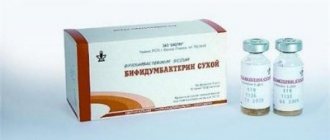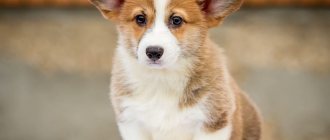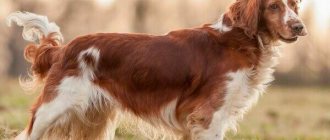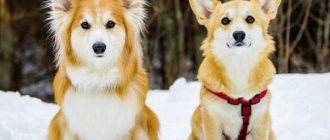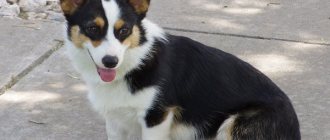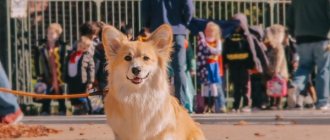Choosing a good purebred puppy is always difficult. Let's say it has already been decided that in terms of temperament and size, a miniature Welsh Corgi shepherd is best suited. But choosing the breed of your future pet is half the battle.
It is advisable to consult with an experienced dog handler regarding the characteristics of the breed and the cost of its representatives. Only after this can you look for a good breeder who will tell you about the features of caring for the baby.
What does a newborn puppy look like?
Puppies are born completely helpless - blind, deaf and toothless. They only know how to move their heads, crawl and suck milk. Newborn Welsh Corgis are very susceptible to temperature changes and are therefore dependent on an external heat source.
During the first days, babies sleep most of the time, waking up only to eat. They cannot defecate on their own. Mommy licks their belly - this is a kind of massage to improve digestion. Corgi puppies are covered with short hair that fits tightly to the body, and so far bear little resemblance to adults.
Breed standard
The first standard was developed in 1934, when Cardigans were identified as a separate breed. These dogs have a remarkable appearance: a small elongated body, short legs, a pretty face with large erect ears and lively, attentive eyes. Due to the special structure of the jaw, the dog seems to be smiling.
In terms of size, the Cardigan Welsh Corgi is a medium-sized breed. At the withers they reach a height of 30 cm, weighing on average 10-11 kg. But in an adult male, the weight can reach 14-17 kg, and these dogs are also prone to obesity.
Head
The head is proportional, moderately wide, the muzzle is elongated, but not sharp. The jaws are strong, elongated, with a scissor bite. The cheeks are pronounced, but do not droop, the lips fit tightly. The bridge of the nose is straight, the stop is pronounced. The lobe is large and black.
The eyes are oval, widely set. The color is dark, but individuals with the blue color may have blue eyes. Sometimes heterochromia occurs, when one eye is brown and the other is blue. The look is expressive, intelligent, friendly. The ears are medium in size, erect, with rounded tips. They are open forward and slightly set apart.
Body type
The body is elongated, located low to the ground. The length to height ratio should be 3:2. The neck is long, muscular, and the shoulders are sculpted. The chest is wide, deep, withers are well defined. The back is long, level, the loin is short, the stomach is slightly tucked. The tail is low set, long, reaching the ground. The dog keeps it down. A tail curled into a ring or thrown over the back is not allowed.
Limbs
The limbs are short but strong. The front ones are slightly turned out, repeating the shape of the chest. This is due to the fact that dachshunds were used in Cardigan breeding. The paws are large, wide, oval, with plump pads. Dogs of any color have white paws.
Coat and colors of the Cardigan Welsh Corgi
The coat is of medium length, smooth, lying close to the body. It is formed by moderately hard guard hair and thick undercoat. The coat should not be soft, wavy or very hard.
The colors of cardigans can be different. Only one color is not allowed; two or three colors must be combined. There may be white spots, but this color should not predominate. The following colors are common:
- brindle;
- merle (or blue merle or white merle);
- red and white;
- black and tan;
- sable - a combination of red and white with black tan.
The most popular colors are tiger, marble (blue). The rarest ones are black and tricolor (black-white-red).
Photos complement the description of Welsh Corgi cardigans:
Stages of development by day in the 1st month
The growth dynamics of a Welsh Corgi puppy in the first month after birth can be tracked using the table presented.
| Day | Development |
| 1-5 | A newborn puppy is completely defenseless. His eyes and ears are closed, thermoregulation is poorly developed. Organs and systems of the body continue to form. But babies can already distinguish smells and feel warmth. |
| 6-8 | Welsh Corgis quickly gain weight and become more active. Strong puppies push away weak ones in order to quickly get to the nipples. |
| 9-10 | By the end of the first week, babies double their weight. |
| 11-15 | Welsh Corgis begin to see. Puppies react to light, but cannot distinguish objects well, since the retina of the eye is still developing. Some babies are already trying to stand on their paws. |
| 16-18 | The thermoregulation system is developing, puppies can already do without an external heat source. |
| 19-21 | The ear canals open. Welsh Corgis try to climb out of the nest to relieve their natural needs. As puppies begin to erupt their baby teeth, they begin to be fed solid food. |
| 22-24 | The Welsh Corgi learns to bite and chew food. The sucking instinct gradually fades away. Puppies actively explore the world and are less dependent on their mother. |
| 25-30 | The phase of socio-psychological development begins. Puppies are taught to respond to a name, go to the toilet in a certain place, and follow the owner. During this period, it is useful to introduce Welsh Corgis to new sounds, smells, objects and people. |
Features of development from 1 to 12 months
The first year of life is the most crucial period in a dog’s life. During this time, the Welsh Corgi puppy develops both physically and psychologically. The animal develops behavioral habits and character traits.
1 month
The Welsh Corgi puppy is actively developing:
- becomes more independent;
- undergoes primary socialization;
- learns to cope without his mother.
During this period, babies are especially vulnerable and sensitive to external influences.
By the end of the first month, the puppy can weigh from 1.1 to 1.8 kg and its height is 14-16 cm.
2 months
The puppy plays with pleasure with his brothers and toys, is interested in everything that happens, and learns communication skills. His teeth are coming through - canines and incisors. A corgi that has been under its mother's care for 2 months can now go to a new home.
The baby stretches up to 16-20 cm at the withers, gaining weight 2.1-2.9 kg.
3 months
Socialization continues, the little Welsh Corgi learns about the world around him. His individual qualities are formed, his own “I” appears, and his activity increases. At this age, strong and weak puppies are clearly visible.
Height at the withers reaches 20-22 cm, weight – 2.8-4.1 kg.
4 months
The puppy's teeth are changing. The Welsh Corgi experiences discomfort and may become less active. At 4 months, the baby acquires a strong immune system - he is no longer so susceptible to adverse factors.
The height at the withers increases by another couple of centimeters, the weight reaches 4.1-5.4 kg.
5-6 months
Hormonal changes associated with puberty occur. Negative changes in the behavior of Welsh Corgis often appear, especially in boys:
- disobedience to the owner;
- attempts to escape;
- excessive activity;
- increased excitability.
The boys are trying to make their first cages, but they are not yet ready to breed.
The height of the Welsh Corgi is 20-28 cm, weight - 5.6-8.5 kg.
7-9 months
The formation of the dog’s individual behavioral characteristics continues. A Welsh Corgi puppy learns to assess its environment and choose the right behavior model.
Girls are going into their first heats. But the dog is not yet ready for mating, either mentally or physically. If you breed a dog too early, its development will stop, which will prevent it from becoming an excellent breeding female.
For your information. The RKF allows breeding dogs of small breeds, which include Welsh Corgis, only at a certain age: boys from 12 months, girls from 15 months, but not before the second heat.
The Welsh Corgi does not grow as rapidly. Height reaches 28-30 cm, weight – up to 7.2-8.5 kg.
10-12 months
Puberty ends. The Welsh Corgi clearly distinguishes between “friends” and “strangers” and accepts the established hierarchy within the “pack”. The puppy reaches the size of an adult dog, but the exterior is still being formed. For about another year, the formation of bones and muscles continues.
Adult weight
When examining dogs, veterinarians use a table of corgi weights by month and consider any deviation from the norm to be a suspicion of illness. However, if your pet has “non-standard” sizes, do not panic. A slight deviation from the Corgi breed standard is not a reason for not admitting the animal to a special breed exhibition.
The weight of an adult should not be more than 13 kg. If a corgi of average height weighs 15 kg, we can talk about being overweight (obese). In this case, a veterinarian will help develop a strategy for normalizing body weight. It should be noted that corgis gain weight much faster than they lose weight: this is due to the metabolic characteristics of this breed. Therefore, preventing obesity is much easier than treating it. Every owner who loves to pamper their pet with tasty morsels should understand this. You should also keep in mind that overfeeding your pet for a long time stretches the stomach of dogs, which inevitably leads to excess weight.
Features of caring for puppies
Even a beautiful dog with excellent prospects can be ruined by illiterate care. The correct diet is of primary importance - the health and longevity of the pet largely depends on it.
Important. In order for the puppy to develop harmoniously, he is given vitamin and mineral supplements, which are chosen together with the veterinarian.
It is equally important to carry out hygiene procedures:
- bathe the baby once every 2-3 months;
- comb every 2-3 days;
- inspect and wipe your eyes daily;
- brush your ears and teeth once a week;
- Trim nails every 2-3 weeks.
Dogs are wormed once every 3 months, and in the warm season they are regularly treated for blood-sucking parasites. Once every six months it is useful to carry out a hygienic haircut - remove damaged hair ends, shorten the hair between the toes and around the genitals.
Optimal nutrition
At the stage of choosing a future pet, a person must clearly understand that he will have to feed it with high quality. Feed! And this concept does not hide feeding cutlets, sausages, sausages or other delights from the master’s table. The dog must receive proper, balanced nutrition.
A well-designed menu is a guarantee of the dog’s health and well-being, and also that you will not be a regular visitor to veterinary clinics.
Whether or not to prepare natural food for your pet daily is the owner’s decision. Not everyone has enough time to cook. Most people prefer ready-made commercial feed.
The owner’s main task is to choose high-quality food: premium or super-premium.
You can determine if food is suitable or not based on the following criteria:
- The pet looks great;
- Excellent wool;
- There are no stool abnormalities;
- Doesn't bother your ears;
- There are no skin diseases;
- No discharge from the eyes;
- Normal weight.
If the indicators coincide with reality, then you are incredibly lucky. They don’t look for good from good - don’t change the brand unless absolutely necessary.
Feeding frequency
The younger the puppy, the more often he needs to be given food:
- up to 2 months – 6 times a day;
- from 2 to 3 months – 5 times a day;
- from 3 to 6 months – 4 times a day;
- from 6 to 8-10 months – 3 times a day.
Then the Welsh Corgi is transferred to 2 meals a day.
What to feed for the first 3 months
A Welsh Corgi puppy should receive light food, which is dominated by meat and dairy products. For the first 3 months, the diet includes:
- lean meat: turkey, beef, rabbit, chicken (with caution, there may be allergies);
- offal: heart, liver, udder, tripe (1-2 times a week);
- rice, buckwheat, oatmeal;
- fermented milk products with low fat content (cottage cheese, kefir, yogurt);
- vegetables (pumpkin, carrots, beets, cabbage) and fruits (pears, apples);
- chicken or quail eggs (once a week).
Unfamiliar food is given in small portions, monitoring the body's reaction.
Obesity in pets
Obesity is a disease caused by low activity in the shepherd dog and improper feeding. The cause may also be hereditary characteristics.
At the first signs of obesity, it is necessary to reconsider the feeding diet . Carbohydrates and fatty meats should be excluded. Add vegetables and fruits, but leave the meat in the same quantities.
After eating the food, when the dog has moved away from the bowl, the bowl must be removed. At the next feeding, reduce the amount of feed.
Even if the dog receives one tablespoon of food and does not touch it, it still should not receive the next portion earlier than usual.
Sample menu for the week
The indicative menu for the week presented in the table will help you create the right diet for your Welsh Corgi puppy.
| Day of the week | Eating | Products |
| 1 | Breakfast | Kefir/cottage cheese |
| Dinner | Buckwheat porridge with offal | |
| Dinner | Boiled sea fish | |
| 2 | Breakfast | Curdled milk/kefir |
| Dinner | Oatmeal with meat | |
| Dinner | Stewed cabbage with meat | |
| 3 | Breakfast | Cottage cheese/yogurt |
| Dinner | Rice porridge with meat | |
| Dinner | Stewed beets with meat | |
| 4 | Breakfast | Like 1 day |
| Dinner | ||
| Dinner | ||
| 5 | Breakfast | Fruits with cottage cheese, egg |
| Dinner | Rice porridge with meat | |
| Dinner | Curdled milk/kefir | |
| 6 | Breakfast | Like on day 2 |
| Dinner | ||
| Dinner | ||
| 7 | Breakfast | Cottage cheese/yogurt |
| Dinner | Rice porridge with meat | |
| Dinner | Buckwheat porridge with stewed carrots |
Welsh Corgis are trained to eat food within 15 minutes. Then the bowl is removed, even if the puppy has not finished eating. Over time, he will get used to the regime.
Breed traits
Breed traits (on a 5-point scale)
| Welsh Corgi Cardigan | |||
| Activity | in the house | 3.1 | |
| on the street | 3.9 | ||
| Obedience | training | 4.3 | |
| strangers | 3.6 | ||
| Domination | in family | 1.6 | |
| over dogs | 2.8 | ||
| Defending your territory | from people | 2.1 | |
| from dogs | 2.8 | ||
| Sociability | in family | 4.9 | |
| with strangers | 3.8 | ||
| with dogs | 4.3 | ||
| Concentration | in family | 1.3 | |
| in front of strangers | 2.8 | ||
| with dogs | 2 | ||
| Aggressiveness | in family | 1.1 | |
| to strangers | 1.5 | ||
| to the dogs | 2 | ||
| to cats | 2.1 | ||
| Family behavior | calmness | 4.6 | |
| demand for affection | 4.5 | ||
| excitability | 3.5 | ||
| playfulness | 4.5 | ||
| excessive barking | 2.4 | ||
| behavioral breakdowns | 2.3 | ||
| Tolerance for children | up to 4 years | 4.4 | |
| over 4 years old | 4.6 | ||
| Institutional use | watchman | 4.6 | |
| bodyguard | 1.8 | ||
This breed is often compared to the following dog breeds: Beagle, Pembroke Welsh Corgi, Pomeranian, Akita Inu, Basenji.
Best photos of Cardigan Welsh Corgis:
Education and training
Welsh Corgi puppies begin to be trained in early childhood. At the initial stages, the dog is taught its own name, after which it is introduced to the most necessary commands:
- "To me!";
- "Place!";
- "It is forbidden!";
- "Ugh!".
Orders are given in a firm but gentle voice. If the Welsh Corgi has performed the required action, it is petted and treated with a treat.
From 3-4 months, the puppy is trained more actively and persistently. It is advisable that the pet knows the commands:
- "Sit!";
- "Lie!";
- "Stand!";
- "Walk!";
- “Aport!”;
- "Give!".
In the future, the puppy can be taught various tricks.
Important. The Welsh Corgi needs systematic physical and mental exercise - you need to exercise it every day.
How to stop barking for no reason
The Welsh Corgi has a clear and loud voice. This breed of dog rarely barks without a reason, but the pet may often disturb the silence if:
- bored;
- something is bothering him;
- wants to attract attention;
- begs for what he needs.
If the puppy is healthy, the best way to stop him from barking is to distract him with play. For example, throw a ball or show your favorite toy. The Welsh Corgi's attention will switch to another object, he will throw out the accumulated energy and calm down.
It is advisable to teach the puppy the “Silence!” command. When he starts barking, you should carefully cover his mouth with your hand, repeating the order several times. Soon the Welsh Corgi will get used to falling silent on its own without outside help.
Important. You cannot shout, hit the puppy or indulge his whims. This will only make the situation worse.
Skinny Corgi
If a corgi puppy is smaller than normal (the animal is very thin), but the dog feels well, the reason for the deviations probably lies in the activity of the animal. If a dog is constantly on the move, he will quickly lose excess weight, and at an early age this is normal. Over the years, the metabolism slows down, and the dog inevitably gains kilograms, surprising the owner with the dimensions of his body.
Owners are often concerned that the dog's two lower ribs are visible. In fact, this is completely normal. Most often, this phenomenon is the result of active sports and muscle building. A lean, fit pet will feel much better than a plump, clumsy dog.
You should be alert to the phenomenon when a dog eats greedily and a lot, but remains painfully thin. The animal probably lacks the enzymes needed to break down food. Another possible reason is parasites. A veterinarian will suggest a solution to this problem.
Excessive thinness of a pet is not a reason to panic
Vaccination schedule
Welsh Corgi puppies are vaccinated according to the standard schedule:
- at 8-10 weeks: complex vaccination against leptospirosis, parainfluenza, distemper, parvovirus enteritis, hepatitis, adenovirus;
- at 12-13 weeks: vaccination against the same diseases + against rabies (by decision of the veterinarian, vaccination against rabies can be postponed until after the change of teeth);
- at 6-7 months (after changing teeth): comprehensive vaccination;
- at 12 months: comprehensive vaccination.
In the future, Welsh Corgis are revaccinated annually. The most commonly used vaccines are Nobivak.
For your information. At first, vaccinated puppies may feel unwell. If symptoms persist, you should contact your veterinarian.
Choosing a pet
The choice of a puppy should be approached with all responsibility, so as not to be disappointed in the dog later and not to spend huge sums on its treatment.
At what age can you adopt a puppy?
Welsh Corgi puppies are separated from their mother no earlier than 6-8 weeks. Show dogs are adopted later - at 6-7 months, when their anatomical and behavioral characteristics become visible.
Which gender to choose
Both boys and girls Welsh Corgis make excellent companions - loyal, kind and cheerful. However, dogs have characteristics that depend on gender:
- Boys are more straightforward and assertive. They are often bred for exhibitions and sports. Males do not go into heat and have no forced breaks for pregnancy and caring for puppies. While on a walk, a dog may run away when it smells a dog in heat.
- Girls are more cunning, but more flexible. Before heat, they can become irritable and disobedient. When the female is “in heat”, she will have to be protected from contact with males in order to avoid accidental mating.
Important. Welsh Corgis have a difficult time giving birth, often requiring a caesarean section. Therefore, breeding them is very difficult.
Every dog has individual traits. To choose a boy or girl corgi, it is better to first decide for what purpose the pet is needed.
What to pay attention to
When choosing a puppy, the following deserve close attention:
- appearance – babies should look well-fed and well-groomed;
- conditions – in good kennels, dogs are kept in clean and spacious premises;
- availability of documents - puppy birth certificate, veterinary passport.
Appearance and physical condition
In healthy Corgi puppies:
- clear view;
- skin without wounds or ulcers;
- shiny wool;
- clean ears and eyes without redness or discharge;
- White teeth;
- moderately well-fed physique.
In boys, both testes should be descended into the scrotum.
For your information. Pembroke Welsh Corgi puppies come in bob-tailed and long-tailed varieties. If the tail is docked, the dog will not be able to participate in international shows in countries where tail docking is prohibited.
Corgi puppies look very touching, they are mobile and agile. Lameness and restricted movements are reasons to refuse the purchase.
Allowed colors:
- corgi-pembroke – puppies can be red, sable, fawn with or without white markings, tricolor (black and tan with white spots);
- cardigan - includes the same colors plus blue merle and brindle.
Dogs of other colors are considered breeding grounds.
Important Tips
A few important recommendations:
- The owner must understand that the dog eats food when it is hungry. If a pet runs happily, jumps, plays, but refuses to eat, you cannot force him to eat or persuade him, beg him, punish him for poor appetite;
- Train your dog to eat a portion of food quickly. A healthy animal eats food in five minutes. It is impossible for a pet to choose, chew for a long time or leave food and finish eating after half an hour;
- The owner must develop strong eating behavior in the dog. After putting the food in the bowl, offer it to your pet. If he sniffs and leaves, remove the cup. When the dog returns, he will realize that there is no food - he will remain hungry. Next time you experience the same behavior, repeat the steps. Sooner or later the dog will learn to eat the portion quickly;
- A puppy at 2-4 months should look well-fed - not thin or fat. After four months, the corgi will lose excess weight and begin to acquire the forms corresponding to an adult. Next, the dog should be in a dry condition. Excess weight is inappropriate here. This is important for the proper formation of the ligamentous, muscular and bone apparatus;
Proper, balanced nutrition is the key to the health of your four-legged friend!
Character and temperament
Welsh Corgis are active and sociable dogs. They lack anger and nervousness. Pembrokes are eternal children at heart, Cardigans are calmer and more reasonable.
Corgi puppies stand confidently on their short legs and always run out to meet a new person. If the baby is too timid or aggressive, it is better to refuse the purchase.
Mandatory questions for the breeder
To choose the right Corgi puppy and ensure the professionalism of the breeder, you should ask the following questions:
- Are the baby and his parents healthy, how long have they been treated for worms, fleas and ticks, have they been vaccinated - a conscientious seller will easily give answers.
- Is it possible to examine the parents - if the breeder hides the sires, it is better to refuse the purchase.
- How many years has a person worked with Welsh Corgis, what are his goals? It’s good if one breed is bred in a kennel, and puppies appear only as a result of planned matings 2-3 times a year.
- What did they feed the baby? - after moving to a new home, the puppy is fed only foods that are familiar to him.
- What is the situation with the documents - the nursery must be registered with the RKF/IKF. The fact of purchasing a puppy is confirmed by a purchase and sale agreement.
There is no need to be shy - a responsible breeder will answer all questions. He is not indifferent to the fate of the puppies, so sincere interest will only strengthen the confidence that he is leaving the baby in good hands.
Where to buy and how much it costs
To purchase a purebred Welsh Corgi puppy, you should contact a reliable kennel or a reputable breeder. Advertisements on the Internet and at poultry markets often sell non-purebred or sick animals.
The Welsh Corgi dog breed is difficult to breed, so puppies are quite expensive. Kids are divided into several classes:
- Pet class - not suitable for exhibitions and breeding, as it has disqualifying defects. These dogs are kept as pets. Cost 20-25 thousand rubles.
- Breeding class - animals with good pedigrees, but some shortcomings that will not allow them to succeed at shows. Widely used in breeding. A Corgi puppy in Russia costs 30-40 thousand rubles.
- Show class are the best individuals with great exhibition prospects: they have almost ideal anatomy and temperament. Cost – from 60 thousand rubles and above.
Famous kennels of the Pembroke and Cardigan Welsh Corgi:
- “Crimson Autumn” https://corgi-pembroke.com (Moscow);
- Aethwyhttps://welshcorgi.ru (Moscow region, Pushkinsky district);
- “FanCorgi” https://fancorgi.ru (Kaluga region);
- “Atsel Hof” https://vk.com/atselhof (Tambov);
- "Arabelde Grand" https://vk.com/pembrokeufa (Ufa).
Welsh Corgis are cute dogs with a unique character and unusual appearance. Having spent time and effort choosing and caring for a puppy, a person will receive a devoted and cheerful friend with whom he will never be bored.
Key facts
The Pembroke Welsh Corgi is an ideal pet and family friend. He adores children, it’s not scary to leave even a baby with him, the dog will forgive them anything. Corgis are perfect for those people who have never had a dog.
The characteristics of the Pembroke Welsh Corgi breed say that these dogs are very social. They love to be the center of attention and do not deny themselves the pleasure of once again cheering up their owner. At the same time, the Pembroke is friends with all family members, without becoming attached to one owner.
The Corgi will always try to stay close to the person, follow the heels, no matter what the owner does. If he wants attention, he will ask for it by gently poking him with his nose. If there is no answer, Pembroke will treat this with understanding and will not bother you anymore. Rather, he will lie down at your feet so as not to miss the moment when the owner is free.
The description of the Pembroke Welsh Corgi breed is replete with positive reviews. This breed is very kind and tolerant of children, they enjoy spending time in their company. They can act as a nanny, protecting the baby from danger and looking after him. No matter how much they are squeezed, they will never show their teeth to the child, but will humbly endure any games.
The Corgi has a keen mind and well-developed intuition, and also quickly and easily adapts to any environment.
The dog understands the owner’s mood well and will not impose his company at the wrong time. She is not touchy or vindictive.
Corgis are very optimistic and have a great sense of humor. If a dog sees that the owner reacts cheerfully to any action, he will definitely repeat it.
Like any herding dog, Welsh Corgis are obedient, not aggressive, but will only obey the commands of an owner who shows sensitivity, love and understanding towards them.
Pembroke Corgis are not very demanding to care for. Their coat is tough and water-repellent, so it does not require frequent washing. Due to their short stature, when walking in damp weather they can get their belly dirty. You can wash it separately with a special shampoo after a walk or get a jumpsuit.
Corgis shed a lot. It is advisable to brush at least once a week, and during the period of active shedding - every day, and also use the services of a groomer.
Pembrokes are prone to obesity, so it is necessary to control your pet’s food intake and prevent him from overeating. In the future, a sedentary lifestyle will negatively affect the spine, joints, as well as the well-being and life expectancy of the Pembroke Welsh Corgi.
The Pembroke Welsh Corgi breed has difficulties with breeding; in 80% of cases, births occur by caesarean section, so if you decide to become a breeder, you should approach this issue carefully and consult with a specialist.
Pembrokes and Cardigans are two separate breeds. They differ both in appearance and in character and temperament. The Cardigan is a more serious dog, while the Pembroke is not averse to fooling around.
Nowadays Pembroke corgis are at the peak of popularity. Their smiling faces collect a huge number of likes on social networks. Be prepared for increased attention on the street and questions like “did she have her legs docked too?”


